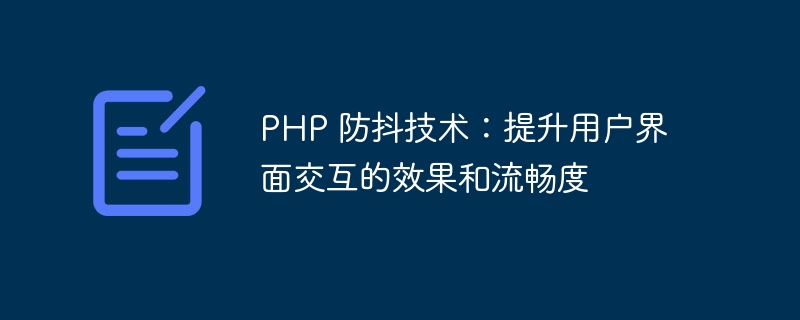

PHP anti-shake technology: To improve the effect and smoothness of user interface interaction, specific code examples are needed
With the continuous development of Internet technology, users’ interaction with web pages Experience requirements are also getting higher and higher. When users interact with web pages, there are often repeated clicks or frequent requests, which will greatly affect the user experience. In order to solve this problem, we can use PHP's anti-shake technology to improve the effect and smoothness of user interface interaction.
The so-called anti-shake technology refers to merging multiple consecutive triggering events into one execution. For example, when the user clicks a button continuously, only the last click operation is performed, while the intermediate click operations are ignored. This can effectively reduce invalid requests and improve user interaction experience.
So, how to implement anti-shake technology in PHP? Below I will introduce it through specific code examples.
First, we need to define an auxiliary function debounce to achieve the anti-shake effect. This function receives two parameters: the callback function to be executed and the delay time. When an event is triggered, this function will delay the execution of the callback function for the specified time. If the event is triggered again within the delay time, the last delayed execution will be cleared and timing will start again.
function debounce($callback, $delay) {
// 定义一个闭包变量来保存定时器
$timer = null;
return function() use ($callback, $delay, &$timer) {
// 清除上一次的定时器
if ($timer) {
clearTimeout($timer);
}
// 开启新的定时器
$timer = setTimeout($callback, $delay);
};
}Next, we can define a simple example to verify the effect of anti-shake technology. Suppose we have a button. Every time the button is clicked, an Ajax request is sent to the server and the data on the page is updated.
// 处理Ajax请求的回调函数
function ajaxRequest() {
// 真实的数据请求部分,请自行补充
// 模拟请求完成后的操作
echo '请求完成';
}
// 创建一个防抖函数,延迟500毫秒执行回调函数
$debouncedAjaxRequest = debounce('ajaxRequest', 500);
// 监听按钮的点击事件
if ($_POST['action'] == 'click') {
// 调用防抖函数
$debouncedAjaxRequest();
}In the above sample code, we create a debouncedAjaxRequest function and set the delay time to 500 milliseconds. In the button click event, we call this anti-shake function to execute the ajaxRequest callback function.
By using anti-shake technology, we can effectively avoid multiple requests caused by users frequently clicking buttons. When the user clicks the button, the timer will first be started, and then the click event will be triggered again within 500 milliseconds. If the click event is triggered again within 500 milliseconds, the last timer will be cleared and timing will start again. Only when the user does not trigger the click event again within 500 milliseconds, the ajaxRequest callback function will be executed to complete the data request.
Using anti-shake technology can improve the effect and smoothness of user interface interaction. When users frequently click buttons, there will not be multiple invalid requests, which reduces the pressure on the server and improves the user experience.
Of course, the above is just a simple example of anti-shake technology, and the specific implementation method will vary depending on the project. In practical applications, appropriate adjustments and improvements can be made according to specific needs and scenarios.
In summary, PHP’s anti-shake technology can effectively improve the effect and smoothness of user interface interaction. By merging multiple consecutively triggered events, invalid requests are reduced, which not only improves the user experience, but also reduces the load on the server. I hope the above code examples can help readers better understand and apply anti-shake technology.
The above is the detailed content of PHP anti-shake technology: improve the effect and smoothness of user interface interaction. For more information, please follow other related articles on the PHP Chinese website!
 Ouyi trading platform app
Ouyi trading platform app
 Python online playback function implementation method
Python online playback function implementation method
 What does data encryption storage include?
What does data encryption storage include?
 The role of validate function
The role of validate function
 Solid state drive data recovery
Solid state drive data recovery
 What is the difference between webstorm and idea?
What is the difference between webstorm and idea?
 Second-level domain name query method
Second-level domain name query method
 What is the transfer limit of Alipay?
What is the transfer limit of Alipay?
 What should I do if eDonkey Search cannot connect to the server?
What should I do if eDonkey Search cannot connect to the server?




